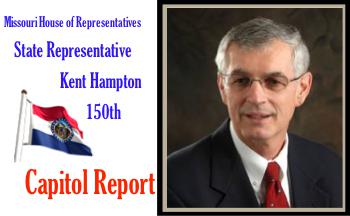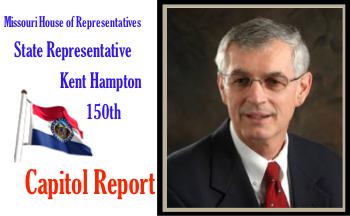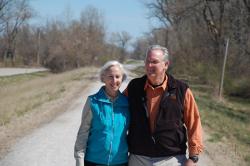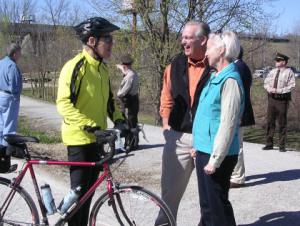
Submitted by
Dee Loflin, SMT Manager/Writer
Jefferson City, Missouri - Gov. Jay Nixon today ordered the deployment of 50 military policemen of the Missouri National Guard to assist local civil authorities in protecting lives and property threatened by flash floods in areas of southern Missouri impacted by flooding from recent heavy rain.
“The Citizen-Soldiers of the Missouri National Guard are one of our most valuable assets in helping Missourians during and after natural disasters, and their skill and training will greatly assist state and local emergency responders in taking necessary action to save lives,” Gov. Nixon said.
This morning, Gov. Nixon spoke to elected officials in Laclede, Miller, Phelps and Pulaski counties about the situation in each of those counties, and about the ongoing assistance from the state.
Yesterday, the Governor declared a state of emergency after heavy rains caused flash flooding and at least one confirmed death in the Waynesville area. That executive order activated the Missouri State Emergency Operations Plan, which allows state agencies to coordinate directly with local jurisdictions to provide emergency services.
In addition to the deployment of the Missouri National Guard, the Missouri State Highway Patrol has deployed additional marine operations troopers, a rescue helicopter and associated assets to the region to assist local emergency responders. At the Governor’s direction, those resources will remain in place until the threat has passed. The State Emergency Management Agency is actively monitoring conditions and will continue to work with local response agencies to provide additional support as needed.
The Governor urged residents of flood-affected areas of southern Missouri to pay close attention to weather warnings and follow the safety instructions of local officials as the potential for additional dangerous flooding continues. Missourians, especially motorists, are encouraged to remember these important safety tips on flooding and high water:
• Do not walk through moving water. Six inches of moving water can make you fall. If you have to walk in water, walk where the water is not moving. Use a stick to check the firmness of the ground in front of you.
• Do not drive into flooded areas. If floodwaters rise around your car, abandon the car and move to higher ground if you can do so safely. You and the vehicle can be quickly swept away. Six inches of water will reach the bottom of most passenger cars, causing loss of control and possible stalling.
A foot of water will float many vehicles. Two feet of rushing water can carry away most vehicles, including sport utility vehicles and pick-ups. Even if the water appears shallow enough to cross, don’t try it. Water hides dips in the road. Worse yet, there may be no road at all under the water. Flooding can scour away the entire road surface and a significant amount of ground beneath.

Submitted by
Dee Loflin, SMT Manager/Writer
The Smithsonian Institution Act
by President James K. Polk
After a decade of debate about how best to spend a bequest left to America from an obscure English scientist, President James K. Polk signs the Smithsonian Institution Act into law.
In 1829, James Smithson died in Italy, leaving behind a will with a peculiar footnote. In the event that his only nephew died without any heirs, Smithson decreed that the whole of his estate would go to "the United States of America, to found at Washington, under the name of the Smithsonian Institution, an Establishment for the increase and diffusion of knowledge." Smithson's curious bequest to a country that he had never visited aroused significant attention on both sides of the Atlantic.
Smithson had been a fellow of the venerable Royal Society of London from the age of 22, publishing numerous scientific papers on mineral composition, geology, and chemistry. In 1802, he overturned popular scientific opinion by proving that zinc carbonates were true carbonate minerals, and one type of zinc carbonate was later named smithsonite in his honor.
Six years after his death, his nephew, Henry James Hungerford, indeed died without children, and on July 1, 1836, the U.S. Congress authorized acceptance of Smithson's gift. President Andrew Jackson sent diplomat Richard Rush to England to negotiate for transfer of the funds, and two years later Rush set sail for home with 11 boxes containing a total of 104,960 gold sovereigns, 8 shillings, and 7 pence, as well as Smithson's mineral collection, library, scientific notes, and personal effects. After the gold was melted down, it amounted to a fortune worth well over $500,000. After considering a series of recommendations, including the creation of a national university, a public library, or an astronomical observatory, Congress agreed that the bequest would support the creation of a museum, a library, and a program of research, publication, and collection in the sciences, arts, and history. On August 10, 1846, the act establishing the Smithsonian Institution was signed into law by President James K. Polk.
Today, the Smithsonian is composed of 19 museums and galleries including the recently announced National Museum of African American History and Culture, nine research facilities throughout the United States and the world, and the national zoo. Besides the original Smithsonian Institution Building, popularly known as the "Castle," visitors to Washington, D.C., tour the National Museum of Natural History, which houses the natural science collections, the National Zoological Park, and the National Portrait Gallery. The National Museum of American History houses the original Star-Spangled Banner and other artifacts of U.S. history. The National Air and Space Museum has the distinction of being the most visited museum in the world, exhibiting such marvels of aviation and space history as the Wright brothers' plane and Freedom 7, the space capsule that took the first American into space. John Smithson, the Smithsonian Institution's great benefactor, is interred in a tomb in the Smithsonian Building.
As always, it is an honor to serve you in the Missouri House. If you would like to discuss any issue, please call 573-751-3629. You can also email me at kent.hampton@house.mo.gov . I look forward to hearing from you.

Dee Loflin, SMT Manager/Writer
Christopher Columbus
Sailed the Ocean Blue
Italian explorer Christopher Columbus sets foot on the American mainland for the first time, at the Paria Peninsula in present-day Venezuela. Thinking it an island, he christened it Isla Santa and claimed it for Spain.
Columbus was born in Genoa, Italy, in 1451. Little is known of his early life, but he worked as a seaman and then a sailing entrepreneur. He became obsessed with the possibility of pioneering a western sea route to Cathay (China), India, and the fabled gold and spice islands of Asia. At the time, Europeans knew no direct sea route to southern Asia, and the route via Egypt and the Red Sea was closed to Europeans by the Ottoman Empire, as were many land routes. Contrary to popular legend, educated Europeans of Columbus' day did believe that the world was round, as argued by St. Isidore in the seventh century. However, Columbus, and most others, underestimated the world's size, calculating that East Asia must lie approximately where North America sits on the globe (they did not yet know that the Pacific Ocean existed).
With only the Atlantic Ocean, he thought, lying between Europe and the riches of the East Indies, Columbus met with King John II of Portugal and tried to persuade him to back his "Enterprise of the Indies," as he called his plan. He was rebuffed and went to Spain, where King Ferdinand and Queen Isabella also rejected him at least twice. However, after the Spanish conquest of the Moorish kingdom of Granada in January 1492, the Spanish monarchs, flush with victory, agreed to support his voyage.
On August 3, 1492, Columbus set sail from Palos, Spain, with three small ships, the Santa María, the Pinta, and the Niña. On October 12, the expedition sighted land, probably Watling Island in the Bahamas, and went ashore the same day, claiming it for Spain. Later that month, Columbus sighted Cuba, which he thought was mainland China, and in December the expedition landed on Hispaniola, which Columbus thought might be Japan. He established a small colony there with 39 of his men. The explorer returned to Spain with gold, spices, and "Indian" captives in March 1493 and was received with the highest honors by the Spanish court. He was given the title "admiral of the ocean sea," and a second expedition was promptly organized. He was the first European to explore the Americas since the Vikings set up colonies in Greenland and Newfoundland in the 10th century.
Fitted out with a large fleet of 17 ships with 1,500 colonists aboard, Columbus set out from Cádiz in September 1493 on his second voyage to the New World. Landfall was made in the Lesser Antilles in November. Returning to Hispaniola, he found the men he left there slaughtered by the natives, and he founded a second colony. Sailing on, he explored Puerto Rico, Jamaica, and numerous smaller islands in the Caribbean. Columbus returned to Spain in June 1496 and was greeted less warmly, as the yield from the second voyage had fallen well short of its costs.
Isabella and Ferdinand, still greedy for the riches of the East, agreed to a smaller third voyage and instructed Columbus to find a strait to India. In May 1498, Columbus left Spain with six ships, three filled with colonists and three with provisions for the colony on Hispaniola. This time, he made landfall on Trinidad. He entered the Gulf of Paria in Venezuela and planted the Spanish flag in South America on August 1, 1498. He explored the Orinoco River of Venezuela and, given its scope, soon realized he had stumbled upon another continent. Columbus, a deeply religious man, decided after careful thought that Venezuela was the outer regions of the Garden of Eden.
Returning to Hispaniola, he found that conditions on the island had deteriorated under the rule of his brothers, Diego and Bartholomew. Columbus' efforts to restore order were marked by brutality, and his rule came to be deeply resented by both the colonists and the native Taino chiefs. In 1500, Spanish chief justice Francisco de Bobadilla arrived at Hispaniola, sent by Isabella and Ferdinand to investigate complaints, and Columbus and his brothers were sent back to Spain in chains.
He was immediately released upon his return, and Ferdinand and Isabella agreed to finance a fourth voyage, in which he was to search for the earthly paradise and the realms of gold said to lie nearby. He was also to continue looking for a passage to India. In May 1502, Columbus left Cádiz on his fourth and final voyage to the New World. After returning to Hispaniola, against his patrons' wishes, he explored the coast of Central America looking for a strait and for gold. Attempting to return to Hispaniola, his ships, in poor condition, had to be beached on Jamaica. Columbus and his men were marooned, but two of his captains succeed in canoeing the 450 miles to Hispaniola. Columbus was a castaway on Jamaica for a year before a rescue ship arrived.
In November 1504, Columbus returned to Spain. Queen Isabella, his chief patron, died less than three weeks later. Although Columbus enjoyed substantial revenue from Hispaniola gold during the last years of his life, he repeatedly attempted (unsuccessfully) to gain an audience with King Ferdinand, whom he felt owed him further redress. Columbus died in Valladolid on May 20, 1506, without realizing the great scope of his achievement: He had discovered for Europe the New World, whose riches over the next century would help make Spain the wealthiest and most powerful nation on earth.
A big shout out to the Campbell Cannons baseball team for being Missouri State Champs! See ya in Church Sunday!! The lesson to be learned is “It’s all right to give out, BUT never give up.
As always, it is an honor to serve you in the Missouri House. If you would like to discuss any issue, please call 573-751-3629. You can also email me at kent.hampton@house.mo.gov . I look forward to hearing from you.



